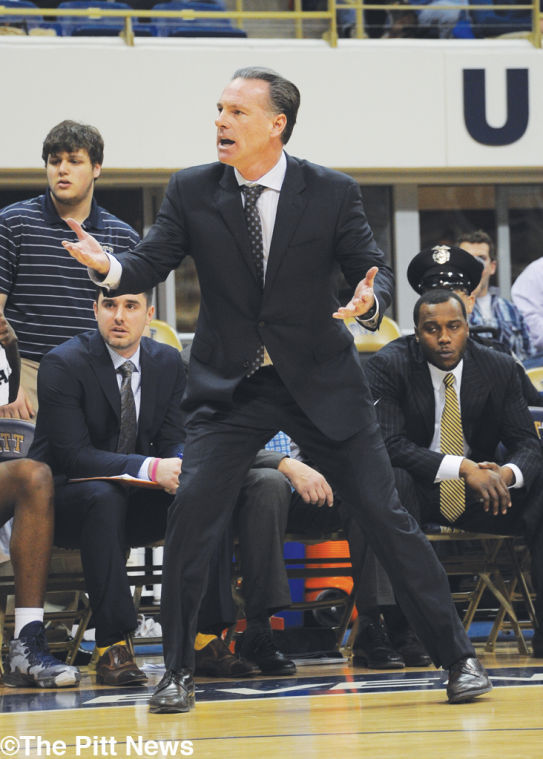Column: Potential rule changes go against Pitt style
April 14, 2014
Long before Georgetown and Oregon tipped off in South Korea to start the 2013-14 men’s college basketball season, the NCAA basketball rules committee made amendments to three primary rules.
The changes limited hand-checking on defense, granted offensive players with more leeway in block-or-charge situations and favored an offensive player’s ability to move without the ball. As a result, scoring and field goal percentage increased in the NCAA Tournament, and year-long increases were seen in attempted free throws, field goal percentage and 3-point shot percentage.
We’re now eight months removed from the committee’s offseason decisions, and the committee, run by head coaches, is again seeking to change the game.
The committee met with a handful of media members last week in Dallas, and many presumed that the year-old foul rules and their results would dominate the discussion.
This was not the case.
Instead, committee members addressed rules that officials could enforce in the game in the near future, asserting their opinions on each possibility.
If all the proposed rules are ever administered into gameplay, the result would be detrimental to Pitt coach Jamie Dixon’s patented slow-paced, defensive-oriented style of basketball.
Of the possibilities, the first that struck me as a Pitt-killer is the proposal to widen the key.
No dimensions were revealed, but I assume that if the court were to adopt a wider lane, the NCAA would meet the NBA’s dimensions of 16 feet. Keys in college basketball are currently 12 feet wide. This, in turn, would bring on more slashing moves to the hoop by guards and less body-banging on rebound opportunities.
In both cases, Pitt would suffer.
Dixon traditionally recruits guards who are mid-range shooting artists, but who lack the ability to bulldoze their way to the rim. His teams also pride themselves on strong interior rebounding. Last season, Pitt finished 21st among NCAA Division I teams in offensive rebounding efficiency, grabbing a staggering 37.3 percent of offensive boards, according to KenPom.com.
Additionally, a wider key would pave a wider path for teams with athletic swingmen to score more easily because players who profile like Talib Zanna, Pitt’s center this past season, may be positioned farther from the hoop, making it more difficult to provide help-side defense.
The idea would also force teams into having more dimensional rebounding. Zanna’s 8.6 rebounds per game, which tied for third best in the ACC in 2013-14, might have dropped to 6.8 as a result.
A second change which, if put into effect, could legitimately cause Dixon to lose some sleep is reducing the number of timeouts.
Dixon loves his timeouts. Rarely has a recent game gone by in which Dixon and the Panthers had timeouts left in their pocket.
Dixon epitomized this strategy March 1, when he elected to call a timeout with Lamar Patterson en-route to a game-winning, right-handed layup with 2.7 seconds left in a game at Notre Dame.
Dixon had just called a timeout five seconds earlier, too.
Limiting timeouts would certainly cripple his ability to execute his game plan, but self-declared “fan coaches” certainly would not mind. Dixon’s critics often believe better success would come if he provided his squads with less micromanagement and more freelancing opportunities.
The committee also discussed an idea that would continue offensive teams’ 10-second backcourt allotments out of timeouts rather than resetting the clock, which could only hurt Dixon’s teams, since he only shows full-court presses when losing in late-game situations.
Even coaches who opt to throw full-court presses against Dixon’s teams to disrupt their early movement would find success in that route. The concept is a lose-lose situation for Pitt.
Sure, these ideas might hurt Dixon’s system, but the fourth and final concept that stuck out — reducing the shot clock — would kill his chances of succeeding.
Committee members addressed a five-second cut, which would bring the shot clock down to 30 seconds.
The implementation of this rule would give coaches like Dixon, such as Georgetown’s John Thompson III and Virginia’s Tony Bennett ,face two options: adjust their late-shot clock systems or surrender their jobs and coach high school teams.
Last season, the Panthers used up 19.1 seconds per possession and came 286th in average possession length according to KenPom.com.
BYU finished first — or last, depending on how you value patience — as it spent just 13.9 seconds per possession looking for a shot.
This means that, with his current offense, Dixon’s teams would get a shot up every 24 seconds. And without a late-in-the-clock playmaker capable of getting a basket in five seconds, his offense would crumble.
Certainly, it’s hard to speculate whether these hypotheticals could ever become reality.
But the meeting was reportedly not let out until one committee member, Art Hyland, who is currently the secretary-rules editor for the NCAA men’s basketball rules committee, glanced across the table with a stern look.
“We’re not done,” he said.
Go on, Pitt fans. Let the nail biting begin.



